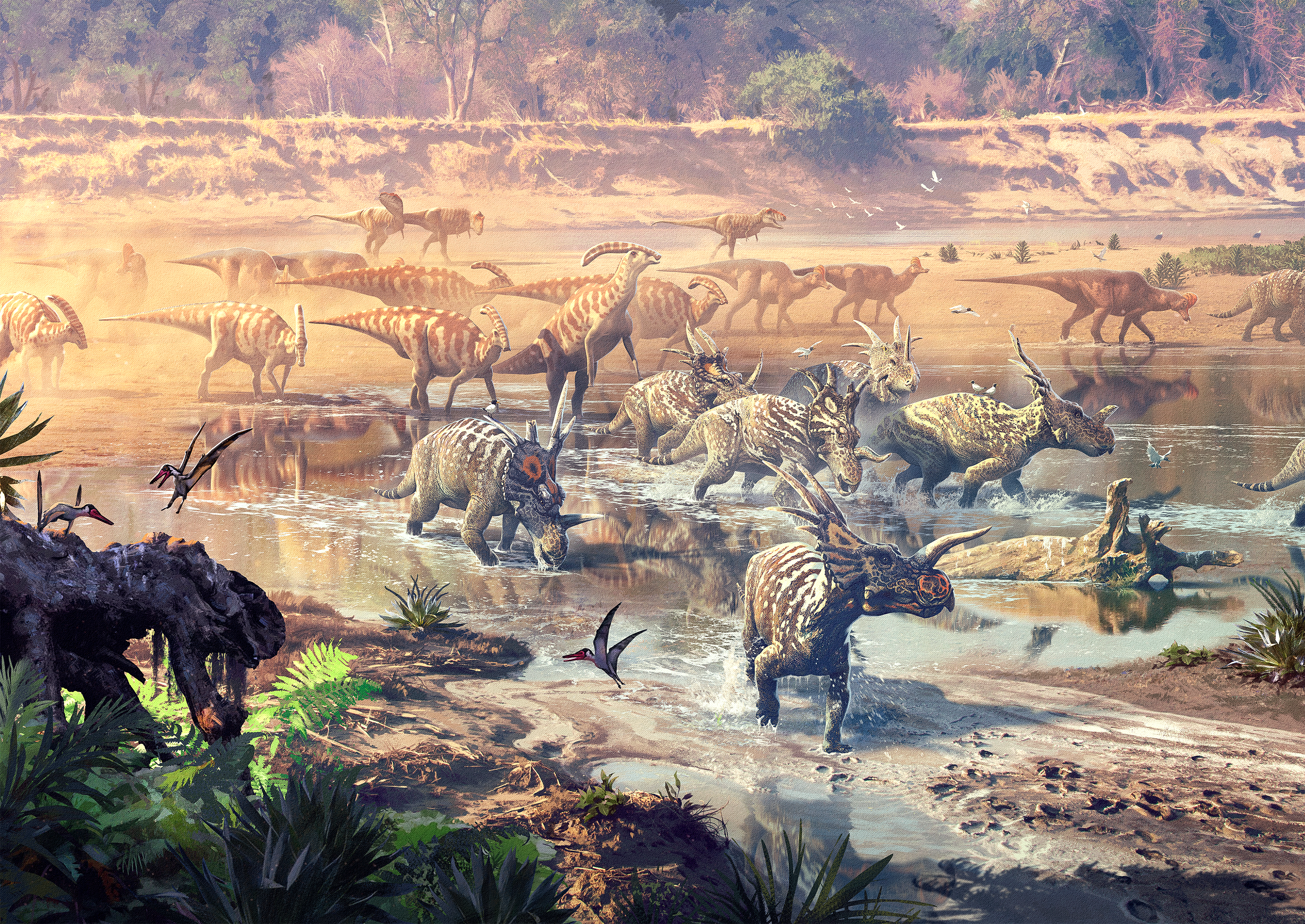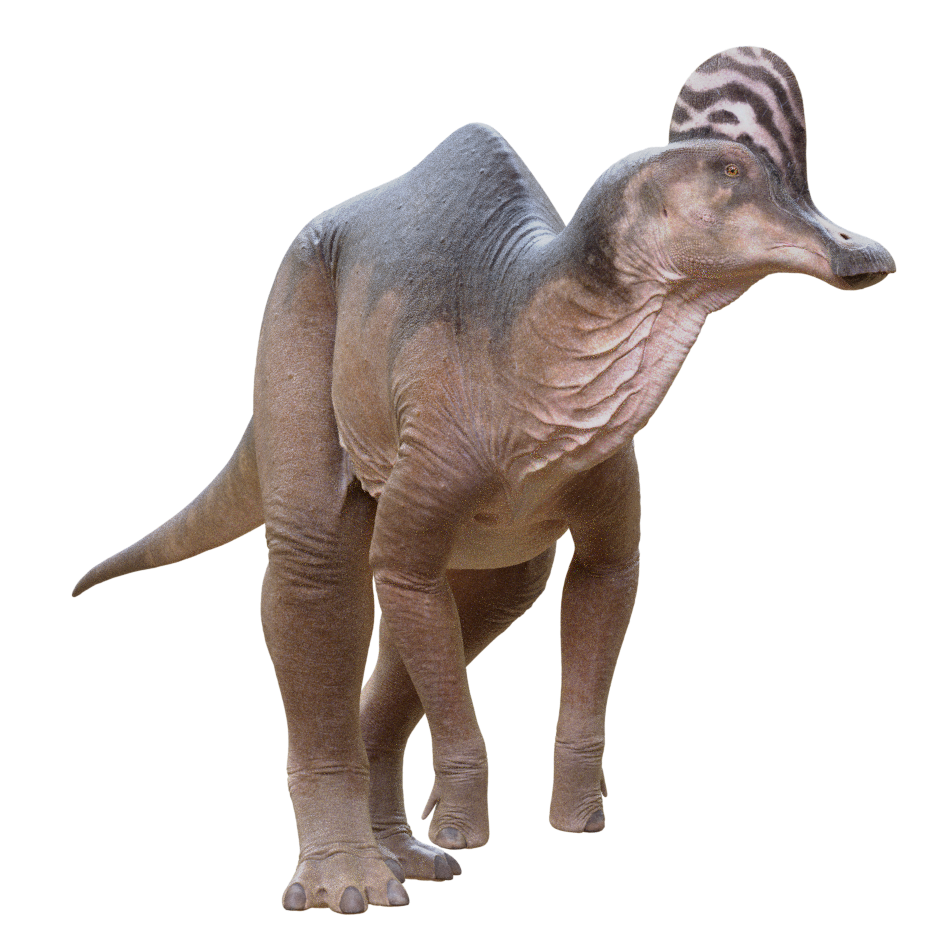The Cassowary-Crests of the Late Cretaceous
Corythosaurus was a hadrosaur or "duck-bill" and is one of the best known herbivores of the Late Cretaceous. It is famous for its rounded head-crest which outwardly resembles the casque of a modern cassowary, and which it probably used for visual display and vocalization.
Overview: Corythosaurus was a hadrosaur or “duck bill” discovered in the early 20th Century in Alberta as a nearly complete skeleton, and even including skin impressions. It is known from abundant additional material, including skeletons, skulls, and even gut contents, making it one of the best represented herbivores of the Late Cretaceous. It is famous for its rounded head-crest which outwardly resembles the casque of a modern cassowary, and which it probably used for visual display and vocalization.
Discovery: Corythosaurus was discovered by legendary paleontologist Barnum Brown in 1911 in rocks of the Oldman Formation in Red Deer River, Alberta, Canada. It was collected in 1912, and in 1914, Brown described and named the specimen Corythosaurus casuarius. Corythosaurus means “helmet lizard”, in reference to the animal’s rounded head-crest, from Greek “korythos”, meaning a Corinthian helmet, and “sauros”, meaning lizard. The species name is a reference to the modern cassowary in the genus Casuarius, which has an outwardly similar rounded head-crest. The original specimen of Corythosaurus is almost entirely complete, just missing the forelimbs and the last two feet of the tail. What’s more, the specimen came with skin impressions, which even preserved an outline of the body, making it an especially informative specimen. And since the discovery of Corythosaurus, numerous additional specimens from both the Oldman Formation and Dinosaur Park Formation have added to our understanding of these crested creatures of the Cretaceous.
Evolution: Corythosaurus was an ornithischian (“bird-hipped”) dinosaur in the family Hadrosauridae, commonly called the “duck-bills” due to their flat, blunt, beaked mouths. Hadrosaurs were large, though smaller than most sauropods. They had robust back legs, with shorter, more gracile forelimbs, and they were facultative bipeds, meaning they could move around on four legs or on just two. The hadrosaurs had very advanced grinding teeth and would have had cheeks covering the sides of their faces, making them highly efficient at chewing, a skill many dinosaurs lacked. Corythosaurus was a member of the subfamily Lambeosaurinae which differed from the other subfamily, Saurolophinae, in having narrower bills, shorter skulls, and more elaborate headgear. Where saurolophines generally lacked crests, or had only small crests, lambeosaurines had very prominent and structurally elaborate crests. Lameosaurines may have also preferred different foods and different habitat from hadrosaurines. Other lambeosaurines include well-known genera such as Lambeosaurus and Parasaurolophus. Both subfamilies of hadrosaurs were among the most common and successful creatures in Late Cretaceous North America.
Description: Corythosaurus grew to be about 8.1-9 meters (27-30 ft) in length and weighed about 3.1-3.82 tonnes (3.42-4.21 tons), a large animal, but about average sized for a hadrosaur. It had a flattened, semicircular crest on its head, that may have been colorful in life. This attached to the head and nose, and contained extensions of the nasal passages, making the crest a sort of resonating chamber for sound generation. Skin impressions show that this animal was covered in scales of several types that varied across the body. The belly was probably covered in small conical scales, while the rest of the animal was covered in large bumpy scales interspersed with rows of small pebbly shield-like scales.

Behavior and Ecology: Corythosaurus lived in a rich subtropical environment that was Late Cretaceous Alerta about 77-75 million years ago. It shared its environment with other hadrosaurs including fellow lambeosaurines Parasaurolophus and Lambeosaurus, which each had their own distinctive crests which would have been used to display to members of their respective species, perhaps for attracting mates, and for generating unique sounds. Saurolophines like Brachylophosaurus were also present, as well as ceratopsids like Chasmosaurus and Centrosaurus, and ankylosaurs like Euoplocephalus. Based on their narrower snouts, Corythosaurus and other lambeosaurines appear to have been more selective in their food preferences than saurolophines, probably a form of niche differentiation which allowed so many herbivores to coexist with each other without too much competition. Additionally, the relative rarity of lambeosaurines compared to saurolophines may suggest that lambeosaurines like Corythosaurus preferred more upland habitat where fossilization is less likely, while saurolophines like Brachylophosaurus preferred basins where fossilization is more common, so in addition to niche partitioning, there may have been some degree of habitat partitioning as well. Preserved stomach contents of Corythosaurus show that it ate seeds, twigs, and conifer needles, as well as a more recent development of the Cretaceous, fruit. This implies that they were browsers, probably using their ability to stand on two legs to reach into the lower portions of trees, thus also avoiding competition from ceratopsids and ankylosaurs which would have exclusively fed close to the ground.
Hunting these herbivores were a variety of theropods, including troodontids, and dromaeosaurs which may have preyed upon juvenile Corythosaurus, and the much larger tyrannosaurs Gorgosaurus and Daspletosaurus which would have been the primary predators of adult Corythosaurus. Corythosaurus lacked armor or defensive weapons, and probably had to rely on its size as its defense, and likely formed herds for mutual protection like many large herbivores do today.
Corythosaurus has never been found outside of Alberta, which is unlike many modern herbivores which range across entire continents. This range restriction may have been at least in part due to geographic partitioning of Laramidia (western North America). At the time Corythosaurus lived, Alberta was bounded on the west by the young Rocky Mountains, and on the east by the Western Interior Seaway (WIS). Between these two boundaries was a coastal corridor that varied in east-west width. Where the corridor became very narrow, the mountains and the sea may have restricted the spread of wildlife, creating regional pockets of unique wildlife, slightly different from elsewhere on the continent. The Oldman and Dinosaur Park Formations may have been such a pocket region, thus Corythosaurus is only found in Alberta.
Extinction and Legacy: Corythosaurus appears to have lived until just before 75 million years ago. It may have been replaced by its similar looking relative Hypacrosaurus which lasted until at least 67 million years ago. Corythosaurus can be seen in multiple museums including the Roal Ontario Museum in Toronto, Ontario, Canada, and the American Museum of Natural History in New York City, New York, USA. Corythosaurus made a brief appearance in Jurassic Park III in 2001.
Corythosaurus FAQ
Corythosaurus size / How big was Corythosaurus?
See height, weight, and length.
Corythosaurus height / How tall was Corythosaurus?
Corythosaurus was about 3.2 meters (10.5 ft) tall including its crest.
Corythosaurus weight / How much did Corythosaurus weigh?
Corythosaurus weighed about 3.1-3.82 tonnes (3.42-4.21 US tons), similar to a modern Asian elephant!
How long was Corythosaurus?
Corythosaurus was about 8.1-9 m (27-30 ft) long!
What did Corythosaurus eat?
Corythosaurus ate plants, and preserved stomach contents show that it was a browser, feeding on seeds, twigs, and conifer needles, and fruit.
What is Corythosaurus’s closest living relative?
Like all dinosaurs, the closest relatives of Corythosaurus are the only surviving lineage of dinosaurs today, the birds. Crocodilians, while not dinosaurs themselves, are also more distant cousins of dinosaurs.
Corythosaurus family members / Corythosaurus family / What kind of dinosaur was Corythosaurus?
Corythosaurus was an ornithischian (“bird-hipped dinosaur”) in the family Hadrosauridae (duckbilled dinosaurs) and the subfamily Lambeosaurinae (duckbills with prominent crests), making it a close relative of other iconic herbivores such as Parasaurolophus and Lambeosaurus.
Where did Corythosaurus live? / Where was Corythosaurus found?
Corythosaurus lived in Laramidia (western North America) and has been found in Alberta.
When did Corythosaurus live?
Corythosaurus lived about 77-75.7 million years ago in the Late Cretaceous Period.
What does Corythosaurus mean? / Corythosaurus name meaning
Corythosaurus means “Helmet Lizard”.
What is Corythosaurus’s crest for? / How did Corythosaurus use its crest?
Corythosaurus used its crest for visual display and for generating sounds.

